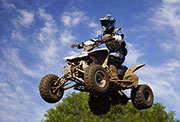- Stigma, Shame Hit Many Gay Men Affected by Mpox Outbreak
- Calories, Not Meal Timing, Key to Weight Loss: Study
- Dietary Changes May Beat Meds in Treating IBS
- Screen Pregnant Women for Syphilis, Ob-Gyn Group Advises
- Even With Weight Gain, Quitting Smoking in Pregnancy Still Best for Health
- A-Fib Is Strong Precursor to Heart Failure
- One Neurological Factor Keeps Black, Hispanic Patients From Alzheimer’s Clinical Trials
- Managing Blood Sugar After Stroke Could Be Key to Outcomes
- Dozens of COVID Virus Mutations Arose in Man With Longest Known Case
- Blood Test Might Someday Diagnose Early MS
Teens, ATVs a Dangerous Combo


A new study from Iowa found that three-quarters of teens in that state have driven an all-terrain vehicle (ATV), and more than half of them have been in accidents while riding one.
The researchers focused on almost 5,000 kids between the ages of 11 and 16, and found most of these young ATV riders had engaged in risky behaviors such as riding with passengers, tooling around on public roads and neglecting to wear a helmet.
“More kids younger than 16 are dying from ATV crashes than from bicycle crashes. We talk a lot about bicycle safety, but there isn’t enough discussed with kids and families about safety when riding an ATV,” said study author Dr. Charles Jennissen, a clinical associate professor of pediatrics and emergency medicine at the University of Iowa Carver College of Medicine.
Since 2001, kids aged 15 and younger have represented nearly 30 percent of all ATV-related injuries and one-fifth of ATV-related deaths in the United States, the authors said in their study, which appears in the July/August issue of the Annals of Internal Medicine.
Previous studies have indicated that young ATV operators have a 12 times greater risk of injury compared with adults, the study authors noted.
For this report, researchers surveyed adolescents at 30 schools across Iowa from November 2010 to April 2013.
About 77 percent of the students reported they had been on an ATV, even though adult-size ATVs come with labels clearly stating they should not be driven by anyone younger than 16.
“The American Academy of Pediatrics does not recommend kids younger than 16 ride ATVs, but in rural areas many families are not following that recommendation,” Jennissen said.
Of those kids, 38 percent said they rode an ATV daily or weekly. “A fairly high percent were regular users,” Jennissen said.
And the bad news — 57 percent of young ATV riders said they had been in a crash. They either hit something with their ATV, rolled the vehicle over or fell off it, Jennissen said.
The young riders also are more likely to do things that could get them into a wreck. About 92 percent had ridden with a passenger, 81 percent had driven on public roads, and 64 percent always or almost always rode without a helmet. Three out of five kids said they had engaged in all three behaviors.
“Kids are not developmentally ready to handle a vehicle like this,” Jennissen said. “It’s a lot of decision making that goes into driving an ATV. It’s not hard to push the throttle and make it go, but there’s a lot more that goes into it than pushing that throttle.”
In Iowa, ATVs are only allowed on roadways for farm use, and kids aged 12 to 15 are only allowed to ride ATVs on public land if they’ve completed a safety course, Jennissen said. However, there are no state laws governing ATV use on private land, outside a universal prohibition on passengers riding on an ATV.
Jennissen acknowledged that the results might be somewhat skewed by the fact that Iowa is a relatively rural state.
But Dr. Mary Aitken, a professor of pediatrics and public health at the University of Arkansas for Medical Sciences, said the “startling data” is “consistent with what’s going on out there in a lot of parts of the country.”
“In our experience here in Arkansas, there’s an under appreciation of the risks of ATV riding by parents,” said Aitken, who is helping revise the current American Academy of Pediatrics policy related to child ATV use. “The vehicles are large and sturdy-looking, and appear more stable than they actually are.”
For example, an ATV’s tires are designed for off-road use. “They aren’t designed for road surfaces,” she said. “They make it more difficult to control and easy to crash. And on the road, in an accident with a car, the car always wins.”
Both Jennissen and Aitken recommend that family doctors ask about a child’s ATV use, and discuss the risks involved with parents.
“We need to be asking our patients and families whether kids are using these vehicles, and discussing safety with them,” Jennissen said. “We should discourage them from riding, but if they do, we need to get them to ride safely.”
More information
Visit the U.S. American Academy of Pediatrics for more on ATVs.
Source: HealthDay
Copyright © 2024 HealthDay. All rights reserved.










